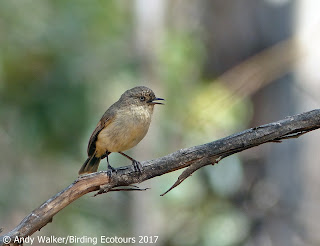Late last November, and into early-December I spent some time in Western Australia. I focused on the southwestern area of the state and on the state endemics of that region, of which there's quite a few.
After arrival in Perth I headed south to the wonderful Dryandra Woodland, home of the gorgeous Numbat (a very rare carnivorous diurnal marsupial), and range of the target endemic birds. I then continued down to the Stirling Ranges before hitting the coast down at the gorgeous Cheynes Beach and Two People's Bay (magical landscape down there) and home of the 'Big Invisible 3' - three of Australia's toughest birds - Western Whipbird, Western Bristlebird, and Noisy Scrub-bird. I then drove north back to Perth via some inland water. It was a great trip, really enjoyable birding and interesting landscapes, the plants seemed more akin to Africa than the rest of Australia! I'll be heading back out to Western Australia at the same time this year so very much looking forward to that! Details here: http://birdingecotours.com/tour/birding-tour-australia-the-southwest-2017?type=country&where=Australia
I managed to get some photos of most of my target birds and I've included these below, along with some notes on those. There was also several species I saw but didn't manage photos of... I actually, eventually got views of all three of the 'Big Invisible 3' but sadly no photos. I had Western Whipbird at Stirling Ranges and Cheynes beach - these two birds are of different sub-species and may warrant full species status, Western Bristlebird was heard at Cheynes Beach and seen very well at Two People's Bay, with Noisy Scrub-bird heard a matter of feet away from me at Cheynes Beach, but no sign as it hid in the undergrowth, only for one to finally give up views later in the day at its usual spot!
But as for the ones I got photos of, see below..... the first set of photographs show some of the main specialist birds of Western Australia (some stretch just into western South Australia also - like the Blue-breasted Fairywren, and Rufous Treecreeper) but the others are totally restricted to Western Australia.
The following species either are of interesting sub-species, and possible potential future splits (mainly with disjunct populations in the east), or just photos I'm pleased with!
After arrival in Perth I headed south to the wonderful Dryandra Woodland, home of the gorgeous Numbat (a very rare carnivorous diurnal marsupial), and range of the target endemic birds. I then continued down to the Stirling Ranges before hitting the coast down at the gorgeous Cheynes Beach and Two People's Bay (magical landscape down there) and home of the 'Big Invisible 3' - three of Australia's toughest birds - Western Whipbird, Western Bristlebird, and Noisy Scrub-bird. I then drove north back to Perth via some inland water. It was a great trip, really enjoyable birding and interesting landscapes, the plants seemed more akin to Africa than the rest of Australia! I'll be heading back out to Western Australia at the same time this year so very much looking forward to that! Details here: http://birdingecotours.com/tour/birding-tour-australia-the-southwest-2017?type=country&where=Australia
I managed to get some photos of most of my target birds and I've included these below, along with some notes on those. There was also several species I saw but didn't manage photos of... I actually, eventually got views of all three of the 'Big Invisible 3' but sadly no photos. I had Western Whipbird at Stirling Ranges and Cheynes beach - these two birds are of different sub-species and may warrant full species status, Western Bristlebird was heard at Cheynes Beach and seen very well at Two People's Bay, with Noisy Scrub-bird heard a matter of feet away from me at Cheynes Beach, but no sign as it hid in the undergrowth, only for one to finally give up views later in the day at its usual spot!
But as for the ones I got photos of, see below..... the first set of photographs show some of the main specialist birds of Western Australia (some stretch just into western South Australia also - like the Blue-breasted Fairywren, and Rufous Treecreeper) but the others are totally restricted to Western Australia.
Blue-breasted Fairywren - got some incredible views of this really beautiful species,this male was very interested in my presence.
Carnaby's Black Cockatoo - several large flocks seen while in the south
Carnaby's Black Cockatoo - often found perched
Gilbert's Honeyeater - this one was coming to a waterbath!
Red-capped Parrot - a really beautiful parrot but rather shy when I had my camera to hand!
Red-eared Firetail - better pics required!
Red-winged Fairywren - great views but they weren't looking as flash as the Blue-breasted.
Rufous Treecreeper - very common
Western Corella (local Muir's Corella sub-species)
Western Rosella - a much smaller bird than the other rosellas of Australia
Western Thornbill - fairly common, a typical thornbill....
Western Wattlebird - not as commonly seen as I'd expected but still seen a few times (here with the very abundant Purple-crowned Lorikeet)
Western Whistler - A recent split from Australian Golden Whistler
White-breasted Robin - typically friendly robin but often in the shaded areas
The following species either are of interesting sub-species, and possible potential future splits (mainly with disjunct populations in the east), or just photos I'm pleased with!
Australian Ringneck (Twenty-eight Parrot)
Brown-headed Honeyeater
Bush Stone-curlew
Common Bronzewing
Fan-tailed Cuckoo - this young bird was being looked after by a White-browed Scrubwren
Nankeen Night Heron
Red-capped Robin
Shining Bronze Cuckoo
Splendid Fairywren
Tawny Frogmouth
Varied Sitella
White-browed Scrubwren (Spotted Scrubwren sub-species)
It wasn't all birds though, there were some great animals about too and I got great views of the very rare and localized Numbat, as well as Short-beaked Echidna and Kangaroos!
Numbat - a diurnal carnivorous marsupial specialized on hunting termites!
Short-beaked Echidna
Western Grey Kangaroo





























No comments:
Post a Comment